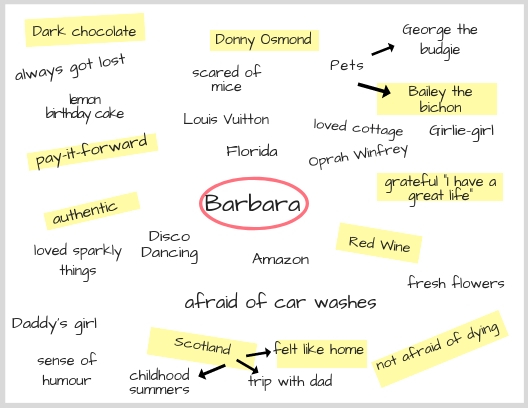
You’ve been asked to give a eulogy. It’s an honour, it’s a privilege and, yes, it’s really hard. But few things in life that are worthwhile come easy, so grab a box of tissues, pour yourself a glass of something (no judgment) and carve out a few hours—because time is what you’ll need to craft a eulogy as unique and special as the life you are remembering.
Personally, I like to start with a “brain dump.” On a blank piece of paper, I write the deceased’s name in the centre and circle it. Now, anything that comes to mind—stories, quotes, songs, traits—I write down in point form on the page. When I can’t think of anything else, I take a short break and, when I return, I highlight the points that really jump out at me—the ones that are relevant and reflect the essence of a life: a person’s teachings, their wit and wisdom, and the legacy they’ve left behind. It often looks something like this:

The brain dump gives you an idea of what you’d like to talk about. Next, you can start building your eulogy keeping the following pointers in mind:
Start Strong.
Capture and keep the attention of your audience by starting with a strong statement. It could be a rhetorical question, an inspirational quote, cherished song lyrics, or a favorite expression. Maybe something like this:
“She once joked that red wine and dark chocolate were the keys to her heart.”
You can also take this opportunity to establish a gentle theme to be woven throughout the eulogy. Go easy on this though … too much can be, well, too much. How not to start? Avoid clichés like, “We are gathered here…” Everyone knows why they’re gathered. It’s a funeral.
Show, Don’t Tell.
Author and researcher Brené Brown says, “Stories are data with soul.” Simply reciting a list of facts about a person’s life is definitely not memorable. Instead, create a narrative. Take the audience on a journey through the art of storytelling. But choose carefully. Telling stories for the sake of telling stories is not the goal. Instead, select illustrative stories that reflect the essence and heart of the deceased.
Here’s an example of telling:
“She was a kind and generous boss.”
Now, look how much more powerful it is to show:
“That Christmas, Barbara gifted her employees with not only a lavish bonus but also each received a handwritten personal note of gratitude detailing his or her unique talent and unwavering commitment.”
Keep it Real.
Last year I led a funeral for a high school friend who died at 53 of breast cancer. Dina was very involved in planning her own funeral, and engaged me as her celebrant two years prior to her death. One day, she called me in a panic worried that at her funeral, she would be declared a saint. Dina was funny, generous, sassy, kind, and quirky—but a saint, she was not. Now I’m not suggesting that the ceremony is the appropriate time to air dirty laundry, but we’re all striving to live authentic lives, and our funerals should be no different.
Sprinkle with Humour.
Note I said sprinkle, not soak—this is not the time to test your stand-up comedy routine (although, if Uncle Jack was a comedian, this rule might get thrown out the window). Laughing and crying are closely related, and injecting a note of levity can be a welcome addition to an otherwise heavy moment. But a word of caution: if there are any questionable stories you are tempted to tell, it’s always a good idea to check with family members first.
Capture The Essence and Spare the Details.
You can’t tell someone’s entire life story in the time you have been allotted, so don’t even try. What you want to do instead is peel away the layers and capture their essence. Too many details can muddy a story. The result? You lose your audience.
Write, Edit, Practice … Rinse & Repeat.
Not everyone will agree with me on this, but I don’t believe this is the appropriate time to “wing it.” Emotions and nerves can overwhelm even the most experienced speakers so, when it comes to funerals, do yourself and the audience a favour, and be prepared.
Try to write the way you speak—it will be more natural that way. Use a large font that you are comfortable reading and leave space in the margins to allow for last minute add-ons. Make sure that your words flow and avoid phrases that might cause you to trip over your tongue. Most smartphones come with a voice recording app installed so you can listen back and time yourself. Practice with someone you respect and trust and who is comfortable providing you with honest feedback.
SLOWWW Down.
When we’re nervous, we have a tendency to speak very quickly. Make a conscious effort to slow down and remember that while you might be familiar with the material, the audience is hearing it for the very first time. They might need a moment to absorb what you’ve said before you move on to the next thought. And don’t be afraid of silence or an extended pause. Sometimes, just resting a beat and letting people sit with the quiet is the most effective way to emphasize a point.
Find a Friendly Face or Two.
Eye contact is important in engaging an audience. When I’m speaking to a group—whether it be a funeral or other type of presentation—I always gravitate towards two or three positive-energy individuals in the crowd. Located in different areas of the space, they might be smiling or nodding or just giving me good vibes. If you find it too difficult to look directly at any one person, focus your gaze just above the audience’s heads.
Relax. It’s OK to Cry.
Author Washington Irving said, “There is a sacredness in tears. They are not a mark of weakness, but of power. They speak more eloquently than ten thousand tongues. They are the messengers of overwhelming grief and of unspeakable love.”
If you’ve been asked to speak at someone’s funeral, chances are they were somebody you cared about. Be prepared: this will be an emotionally charged experience for you. But please don’t let a few tears sway you from this incredibly meaningful and potentially healing opportunity. The more familiar you are with your speech the easier it will be to deliver without completely breaking down. But it might happen, and that’s okay. If it does, don’t try to talk through your sobs. Instead take a moment, take a breath, and don’t be afraid to close your eyes while you regroup. Maybe take a sip of water. And, if you just can’t continue, enlist the help of a friend or the officiant/celebrant to carry on for you. Make a plan in advance for someone to act as your back-up.
End with Your Start.
“It’s true Barbara loved dark chocolate and red wine, but it was the people in this room who really held the keys to her heart, and I am grateful to have been considered one of them.”
Tie it up with a bow and let your strong start help with your strong finish. Bring your story and your theme full circle. And remember, you have taken your audience on an emotional journey. Try to end with an uplifting message of hope and gratitude.
I always like to say: “Life has to win.”
* * *
 AUTHOR: LINDA STUART
AUTHOR: LINDA STUART
Linda Stuart is a Life-Cycle Celebrant/Officiant and Speaker located in Toronto, Ontario. Specializing in funerals and weddings, Linda’s passion is bringing stories to life through meaningful ceremonies.
You may also like: 10 Things I Wish You Knew About Funerals| When I Die, Please Do Something | Stella Joy: Celebrating her Small but Mighty Life

Hi Linda, Just shared this piece on my FB Page, The Trauma Project.
beautiful work!
carol